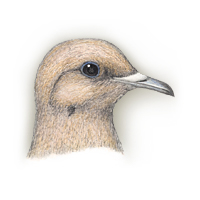 |
Mourning Dove
Zenaida macroura |
|
|
STANFORD LOCATIONS: Common to abundant resident throughout campus. Highly flexible in its use of nesting substrates; nests in a variety of trees and shrubs but also uses planters, artificial ledges, the eaves of buildings, and even old nests of other species. |
 |
Location |
Type |
Mating System |
Parental Care |
2ndary Diet |
Strategy |
|
|
|
|
I: 13-14 DAYS ALTRICIAL |
|
|
|
GROUND 0 - 40 feet |
|
(2-3) MONOG |
MF |
|
|
| BREEDING: | Desert (near water) to open woodland, agricultural areas with scattered trees, suburbs. Typically 2-3, but occ 3-6 broods. |
| DISPLAYS: | Courtship: male performs gliding, spiraling aerial display over female with wingtips held below body; on ground struts before female with feathers spread and head nodding. |
| NEST: | In fork of horizontal tree branch, on ground, on deserted nest of other species, or anywhere else providing solid support; flimsy, usu of crossed sticks and twigs (occ grass, weed stems) lined with fine materials. Female builds but male brings materials. Built in 1 - 3 days; often reused. |
| EGGS: | White, unmarked. 1.1" (28 mm). |
| DIET: | Seeds, including waste grain from cultivated fields, compose >99% of diet. Young fed crop milk for 3 days, then also seeds; entirely seeds by 6-8 days. |
| CONSERVATION: | Winters s to c Panama. Rare host of both cowbird species. Range expanding northward. |
| NOTES: | Champion of multiple-brooding among N.A. birds. Most abundant dove in N.A.; most widely hunted and harvested game bird. Pair bonds occ persist >1 nesting season. Flock for much of year, but not colonial breeder. Eggs always covered: male incubates most of day, female remainder of day, all night. Clutches of 3-4 likely due to brood parasitism by another Mourning Dove. Males produce crop milk 4-6 days longer than females. |
| ESSAYS: | Visual Displays; Feeding Birds; Bird Milk; Range Expansion; Brood Parasitism. |
| REFERENCES: | Leopold et al., 1981; Leopold and Dedon, 1983; Westmoreland et al., 1986. |
| Help | Abbreviations | Species-Alphabetical | Species-Taxonomic | Essays-Alphabetical | |
| Except for Stanford Locations, the material in this species treatment is taken, with permission, from The Birder's Handbook (Paul Ehrlich, David Dobkin, & Darryl Wheye, Simon & Schuster, NY. 1988). | |||||